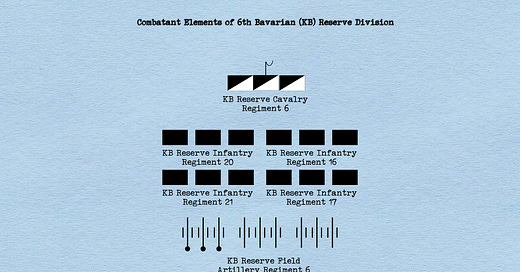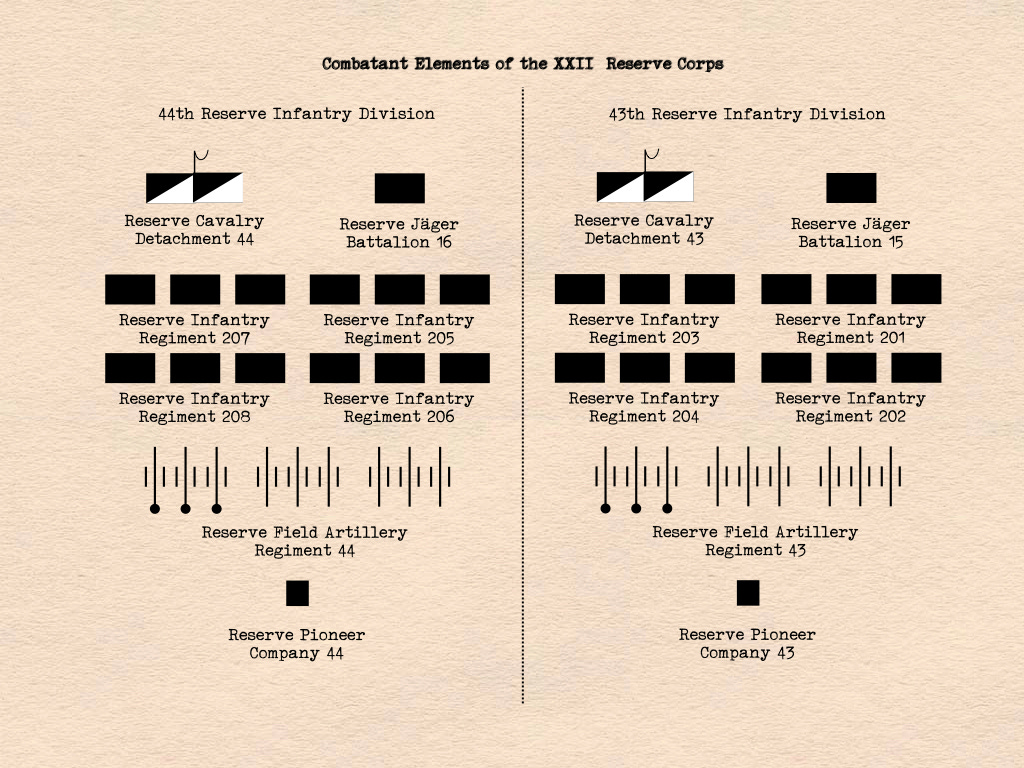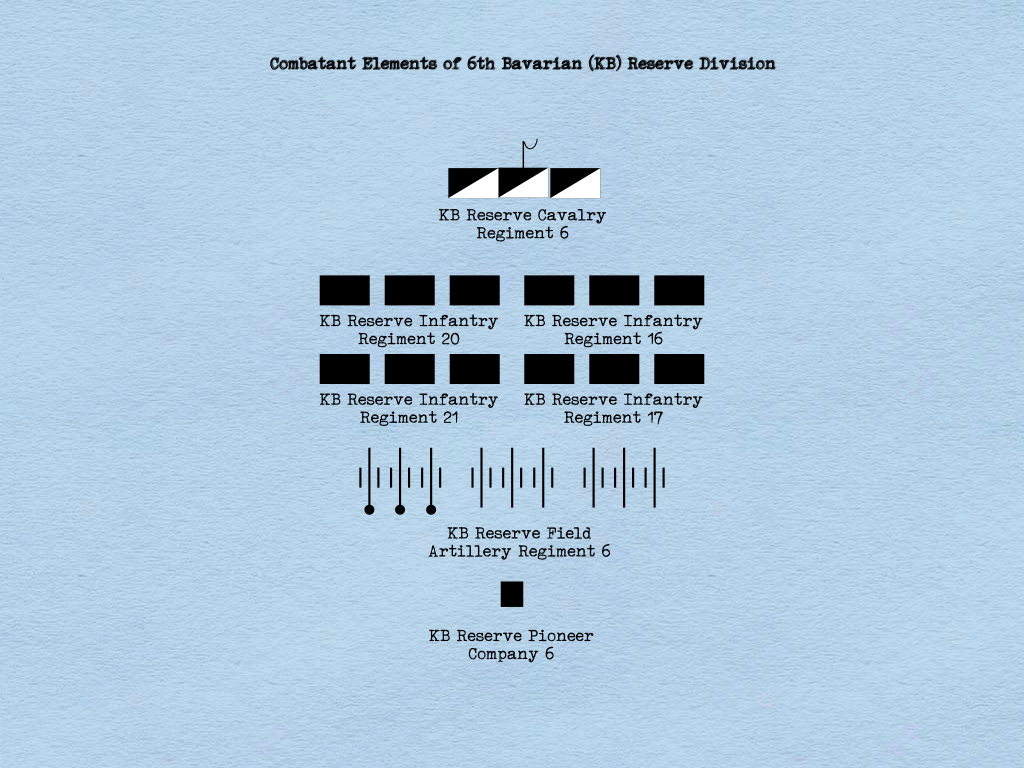The creation of both the Ersatz divisions and the “main reserve of a fortress” Reserve divisions had been greatly facilitated by measures taken in time of peace: the stockpiling of arms and equipment, the designation of leaders, and the writing of plans. The divisions of the first series of formations to be systematically raised by the German Empire after the completion of mobilization, however, were formed without the benefit of such preparations.1
These thirteen divisions owed their existence to the realization that far more men were present for duty with replacement [Ersatz] units at home than the authors of mobilization plans had anticipated.2 Not all of these men were the song-filled “war volunteers” [Kriegsfreiwillige] who would soon be celebrated in German patriotic lore.3 A few were fully trained reservists of older classes who, for one reason or another, had not found a place in units formed in the course of mobilization. A good number were “substitute reservists” [Ersatzreservisten], men who, though surplus to the needs of peacetime army and thus exempted from most (if not all) peacetime training, had remained liable for service in the event of war.4
The officers and non-commissioned officers who trained these men, and, in many cases, would lead them into battle, were those who happened to be serving at regimental depots when, late in August or early in September, the component units of the new divisions were formed. Some of these were recovering from wounds inflicted in the very first days of the war. Others were officers who had been assigned to the depots when their regiments marched off to war. Quite a few were recalled retirees, some of whom had been out of uniform for several years.
Officially characterized as Reserve formations, all but one of the new divisions bore numbers from a new sequence, one that began where numbers given to peacetime infantry divisions of the Prussian Contingent left off.5 Thus, as the junior peacetime division had been the 42nd Infantry Division, the senior division of the first wartime series was called the 43rd Reserve Division. (As might be expected, the exception to this rule was provided by the new division raised by the Bavarian Army.)
Most of the component units of the new divisions were given the same number as the divisions to which they were assigned. Thus, the field artillery regiment, the cavalry detachment, and the pioneer company of the 43rd Reserve Division were known, respectively, as the 43rd Reserve Field Artillery Regiment, the 43rd Reserve Cavalry Detachment, and the 43rd Reserve Pioneer Company. The infantry regiments, of the new divisions, however, were numbered in a sequence that began with two-hundred and one. Thus, the four infantry regiments of the 43rd Reserve Division were the 201st, 202nd, 203rd, and 204th Reserve Infantry Regiments.
The new Jäger battalions formed for each new division also received numbers from a sequence peculiar to their arm. The senior of these units was thus the 15th Reserve Jäger Battalion and the junior the 26th Reserve Jäger Battalion. (On mobilization, each of the fourteen numbered Jäger battalions of the peacetime army had mobilized two units, an active Jäger battalion and a Reserve Jäger battalion. As each of these wartime units bore the same number, the mitosis of the peacetime 14. Jäger Bataillon produced both the active 14. Jäger Bataillon and the 14. Reserve Jäger Bataillon.)
With the exception of the one division provided by the Bavarian Army, the new divisions were formed, two-by-two, into a series of six new army corps. These got numbers from a series that began with twenty-two. Thus, the senior of the new army corps became known as the XXII. Reserve Armee Korps. (The junior army corps of the peacetime Prussian Contingent, which had been formed in 1912, was had been the XXI. Armee Korps.)
Similarly, the two infantry brigades in each of the new divisions received numbers that corresponded to those of the divisions and army corps to which they belonged. Thus, the two infantry brigades of the 43rd Reserve Infantry Division were the 85th Reserve Infantry Brigade and the 86th Reserve Infantry Brigade. (The junior infantry brigade of each new division received a number that was formed by doubling the number of its parent division. Likewise, the number of the junior infantry brigade of each army corps was four times the number of that formation.)
The Kingdom of Bavaria found numbers for the component units of its new Reserve division by using a variant of the same system that it had used for the two Reserve divisions it had formed upon mobilization. Thus, while the field artillery regiment of the 6th Bavarian Reserve Division became the 6th Bavarian Field Artillery Regiment, the infantry regiments were numbered 16, 17, 20, and 21.
The arsenals of the German Empire possessed a sufficient small arms to equip the new divisions, but came up short when it came to field pieces. Thus, the one field artillery regiment of each new division had to make do with nine four-piece batteries. (Three of these were armed with 105mm light field howitzers and six with 77mm light field guns.)
The scheme used here to name the series of new infantry divisions formed systematically after the completion of mobilization is the one used by Ernst von Wrisberg. It begins with the “first series” (erste Räte) and ends with the “fourth series” (vierte Räte).
Prussia, Kriegsministerium, letter MJ 3531/14 A1 dated 16.8.1914 and signed “Falkenhayn,” with enclosed organizational charts, NARA, M-962, Reel 3.
For a description of the legend of the student volunteers, see Robert Cowley, “The Massacre of the Innocents” MHQ, The Quarterly Journal of Military History, Spring 1998. For a detailed analysis of the composition of these divisions, see Alex Watson, “For Kaiser and Reich: The Identity and Fate of the German Volunteers, 1914-1918” War in History, January 2005.
Reserve Infantry Regiment 210, for example, seems to have had comparatively few war volunteers in its ranks. More than half of the 954 men of the 19th Reserve Jäger Battalion who were present for duty on 6 November 1914 were older men who had served full terms “with the colors” in peacetime. Günther Gieraths, Geschichte des Reserve Infanterie Regiments Nr. 210 und seiner Grenzschützformationen (1914-1920), (Oldenburg: Stalling, 1928), page 19 and Albert Fahrtmann, Das Reserve-Jäger-Bataillon Nr. 19 im Weltkrieg, (Berlin: Verlag Tradition Wilhelm Kolk, 1929), page 4
Where the numbering of units and formations were concerned, the Prussian Contingent consisted of units from all states of the German Empire other than Bavaria. Ten of the divisions of the first series, the 43rd through the 52nd Reserve Divisions, were raised in military districts subordinate to the Prussian War Ministry. Of the remaining three divisions, the 53rd Reserve Division originated in Saxony, the 54th Reserve Division hailed from Wurttemberg, and the 6th Bavarian Reserve Division was entirely Bavarian. Ernst von Wrisberg, Heer und Heimat, (Leipzig: Verlag von K.F. Koehler, 1921), page 16 and Cron, Geschichte des Deutschen Heeres im Weltkrieg, pages 98 and 99






